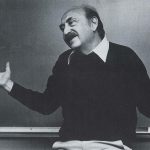David Carson, a revolutionary graphic designer known for breaking the traditional mold of design, emerged from the vibrant counterculture of the late 20th century. Born on September 8, 1954, in Corpus Christi, Texas, Carson’s journey into the world of design took a circuitous route that reflected his nonconformist spirit and penchant for pushing boundaries.
Carson’s early fascination with design was not immediately apparent in his academic pursuits. He initially studied sociology at San Diego State University but later discovered his passion for graphic design during a two-week graphics course. This serendipitous encounter ignited a creative spark, leading Carson to pursue a design career that would ultimately redefine the visual language of the graphic design industry.
In the early 1980s, Carson’s professional journey took a notable turn when he became the art director for Transworld Skateboarding magazine. It was in this role that he first showcased his unconventional and experimental design approach, which would later become a hallmark of his career. Carson’s skateboarding background infused his design work with a rebellious and energetic aesthetic, laying the foundation for his disruptive impact on the design world.
The Grunge Era
The 1990s saw the rise of grunge, a subculture that embraced a raw and unconventional aesthetic. David Carson’s design sensibilities found a perfect match in this cultural shift, and his work at Ray Gun magazine became synonymous with the grunge era. In 1992, Carson assumed the role of art director at Ray Gun, a music and lifestyle magazine that provided a platform for his experimental design philosophy.
Carson’s approach to design at Ray Gun was anything but conventional. He embraced chaotic layouts, non-traditional typefaces, and unpredictable design elements that challenged established norms. The fusion of bold imagery, distorted typography, and layered compositions created a visual language that mirrored the dissonance and spontaneity of the grunge music scene. Carson’s work at Ray Gun not only reflected the spirit of the era but also became a defining force in shaping the visual identity of alternative and youth culture.
One of Carson’s most iconic works during this period was his design for a feature article on Bryan Ferry in the February 1994 issue of Ray Gun. The unconventional use of typography, overlapping elements, and a disregard for traditional layout principles showcased Carson’s willingness to push the boundaries of design. His work at Ray Gun earned him international acclaim and established him as a provocateur in the graphic design landscape.
Beyond Boundaries
David Carson’s influence extended far beyond the grunge era, as he continued to evolve and experiment with his design approach. Following his tenure at Ray Gun, Carson ventured into various design projects, including corporate branding, advertising, and art direction for major brands. His eclectic portfolio demonstrated a versatility that defied categorization, reaffirming his status as a design maverick.
In the corporate realm, Carson’s innovative approach found expression in projects for clients such as Pepsi, Nike, and Microsoft. His ability to inject a sense of rebellion and nonconformity into commercial design challenged traditional notions of corporate branding. Carson’s willingness to blur the lines between art and commerce demonstrated a commitment to maintaining a unique voice within the constraints of commercial design.
Carson’s impact also reached the realm of academia, where he transitioned into teaching and lecturing on design. His insights into the creative process, coupled with his emphasis on individual expression, inspired a new generation of designers. Carson’s role as a mentor and educator underscored his commitment to fostering a spirit of exploration and breaking free from creative constraints.
In recent years, Carson has continued to explore new avenues, including photography and typography. His work retains a sense of experimentation and a refusal to adhere to established norms. The documentary film “David Carson: The End of Print,” released in 2017, provides a retrospective look at his influential career, offering insights into his creative philosophy and the transformative impact he had on the design world.
Unparalleled Legacy in Graphic Design
David Carson’s career represents a departure from the conventional and a celebration of the avant-garde in graphic design. From his rebellious roots in skateboarding culture to his groundbreaking work at Ray Gun magazine and his subsequent ventures into corporate branding and education, Carson’s journey has been marked by a relentless pursuit of creative freedom and a refusal to conform.
As a design icon, Carson’s legacy endures not only in the tangible artifacts of his work but also in the ethos he imparted to the design community. His willingness to challenge norms, embrace chaos, and prioritize individual expression has left an indelible mark on the ever-evolving landscape of graphic design. David Carson’s story serves as an inspiration for those who seek to break free from creative constraints, illustrating the transformative power of pushing boundaries and redefining the visual language of an entire industry.



